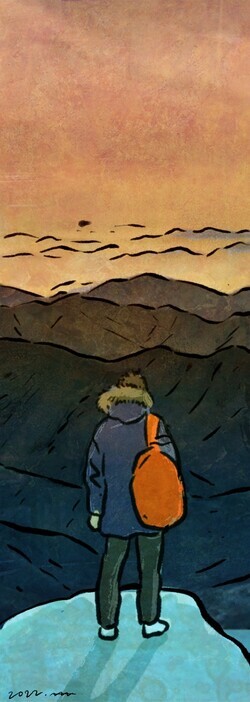hankyoreh
Links to other country sites 다른 나라 사이트 링크
[Column] Survival guide for the new Cold War era


This season, when we celebrate Christmas and New Year’s Day, is supposed to be a time of warmth and happiness. Whenever I email my friends around this time of year, I typically add a note wishing them happy holidays. But this time around, what I feel most intensely is not happiness, but anxiety and fear. The world today is too ugly to be happy during the holidays.
It was only inevitable, I suppose: the hegemony of the Western world has been slowly becoming a thing of the past since the end of the 2010s. Calculated in terms of purchasing power parity, China’s gross domestic product of US$26 trillion has already outstripped the US’ GDP (US$22 trillion), and the gap between the two is steadily widening.
More broadly speaking, it’s no exaggeration to say that we’re returning to the time before the First Opium War, when China’s Qing Dynasty was the center of global production. Meanwhile, the combined GDP of India (around US$10 trillion), Russia (US$4 trillion), Indonesia (US$3 trillion) and Brazil (US$3 trillion) is nearly the same as that of the EU (US$20 trillion), the other axis of the Western world.
Put together, the GDP of South Korea (US$2.5 trillion) and Turkey (US$2.7 trillion) are comparable to that of Japan (US$5.5 trillion). Simply put, the global economy — which once revolved around the advanced economic bloc of the US, Europe and Japan — has been basically bisected, with the West and Japan on one side and the emerging powers of Asia on the other.
It’s not likely that the tempering of the West’s imperial hegemony will proceed peacefully. On the other hand, what one would call imperialism — the capability to mobilize arms industries, massive militaries, intelligence organizations, and propaganda outlets — has already formed in China and Russia.
We often use the term “new Cold War” to refer to this global confrontation between Western imperialism and its antagonists. The winner of the New Cold War isn’t as easy to predict as in the case of the original Cold War, which concluded in 1989. In 1985, prior to perestroika, the Soviet Union’s GDP was less than half that of the US. When the Soviets engaged the US in an arms race in that economic position, they were doomed to defeat.
But China’s productive capacity today far surpasses that of the US, and currently, all that China needs to do is expand influence over global finance, which has hitherto been the sole purview of the West and Japan.
The total population of China, Russia and countries in their orbit (such as Belarus and Kazakhstan) is more than 50% greater than that of the West and Japan. That means that the new Cold War, unlike the old one, is ultimately likely to make global hegemony multipolar — leading, in other words, to the long-term entrenchment of great power competition. That means we’ll have to live with the new Cold War for decades to come, if not longer.
The new Cold War represents conflict and confrontation between imperialist states, just as the previous one did. Since we’re in the age of nuclear weapons, the two sides avoid all-out hot wars, but the Cold War, both then and now, can turn hot in geopolitically critical points along the periphery.
The Syrian civil war still rages on, even though half a million people have died or gone missing since 2011 and half of the country’s total population has been forced to flee. If the Russian army goes beyond simply threatening the West and actually invades Ukraine, the fallout will be just as bad, if not worse.
Speaking personally, my mother was born in eastern Ukraine, and some of my relatives still live in the southeast region of the country. The possibility that their homes could become the battleground of an all-out war fills me with fear and dread in the holiday season, which should be a time of peace and comfort.
What should our attitude be as we live through this perilous time of the new Cold War? First, we ought to remember that the justifications given by both sides in this imperialistic showdown aren’t consistent with reality. Think back to the first nadir of the old Cold War in the 1950s, when the Korean War was at its height. The Soviet Union at the time brutally subjected around 2.4 million prisoners (including 460,000 political prisoners) to slave labor in its concentration camps. That had nothing in common with the beautiful ideals of socialism, despite that being the Soviet ideology. While Soviet society offered many advantages to the common people, its prioritization of rapid development over equality was a far cry from what Marx and Lenin had envisioned.
But was the US — a hotbed of racism — actually a democracy when it refused to grant Black people civil rights? In the end, both the American and Soviet camps merely whitewashed the ugly realities of inequality and exploitation with the fine-sounding slogans of “socialism” and “democracy.” That was acknowledged by conscientious intellectuals in Korea’s reform-minded political parties of the time who explored a “third way.”
How different are the actual conditions in the two sides today? The US held the Summit for Democracy, which was also attended by South Korea, on Dec. 9-10, 2021, with the goal of putting some backbone into the global battle lines of the “Western bloc.” But ironically enough, this coincided with a UK court ruling that Julian Assange could be extradited to the US. How much better is the American brand of democracy, when it uses charges of violating the Espionage Act to persecute and oppress Assange for revealing the inner workings of the US’ invasion of Iraq to people around the world?
Meanwhile, China’s nominal support for a “culture of pluralistic unity,” which recognizes the cultural diversity of various ethnic groups, seems completely divorced from the harsh reality of mass detention and surveillance of the Uyghurs. We must come to terms with the reality that at no point in history have the US or China ever properly realized their espoused ideologies.
But a dispassionate rejection of both sides isn’t all that’s needed in this era of the new Cold War. While that rejection remains valid, at the same time, it’s critical that citizens on both sides join in the struggle to implement the ideals of human rights, democracy and equality within their respective systems.
Let us return once again to the experience of the old Cold War. The behavior of the Western bloc, including the US, in that period was forever transformed by citizens’ vocal opposition to American aggression against “red” Vietnam. By the same token, the reason that Russian citizens still basically enjoy the right to leave their country even now, when confrontation with the West has brought Russia to the brink of a new war, is largely thanks to the struggle by opposition politicians to liberalize immigration rules during the Soviet era.
In South Korea, which was on the front lines of peninsular division and the Cold War during the rule of dictators, Ri Yeong-hui’s pioneering efforts to gain an intimate understanding of the “country to the north” (that is, China) in such books as “A Conversation with 800 Million People” (1977) and “Beyond Division” (1984) paved the way for South Korea’s ultimate thaw with China after the end of the Cold War.
Moving forward, citizens of our era will have to make similar efforts to resist the either-or, black-and-white logic of the new Cold War. We must fight for an objective understanding of the other side as we make a clear-eyed diagnosis of the problems with our own side.
Please direct questions or comments to [english@hani.co.kr]

Editorial・opinion
![[Column] Season 2 of special prosecutor probe may be coming to Korea soon [Column] Season 2 of special prosecutor probe may be coming to Korea soon](https://flexible.img.hani.co.kr/flexible/normal/500/300/imgdb/original/2024/0426/3317141030699447.jpg) [Column] Season 2 of special prosecutor probe may be coming to Korea soon
[Column] Season 2 of special prosecutor probe may be coming to Korea soon![[Column] Park Geun-hye déjà vu in Yoon Suk-yeol [Column] Park Geun-hye déjà vu in Yoon Suk-yeol](https://flexible.img.hani.co.kr/flexible/normal/500/300/imgdb/original/2024/0424/651713945113788.jpg) [Column] Park Geun-hye déjà vu in Yoon Suk-yeol
[Column] Park Geun-hye déjà vu in Yoon Suk-yeol- [Editorial] New weight of N. Korea’s nuclear threats makes dialogue all the more urgent
- [Guest essay] The real reason Korea’s new right wants to dub Rhee a founding father
- [Column] ‘Choson’: Is it time we start referring to N. Korea in its own terms?
- [Editorial] Japan’s rewriting of history with Korea has gone too far
- [Column] The president’s questionable capacity for dialogue
- [Column] Are chaebol firms just pizza pies for families to divvy up as they please?
- [Column] Has Korea, too, crossed the Rubicon on China?
- [Correspondent’s column] In Japan’s alliance with US, echoes of its past alliances with UK
Most viewed articles
- 1[Column] Season 2 of special prosecutor probe may be coming to Korea soon
- 2‘We must say no’: Seoul defense chief on Korean, USFK involvement in hypothetical Taiwan crisis
- 3N. Korean delegation’s trip to Iran shows how Pyongyang is leveraging ties with Moscow
- 4Amnesty notes ‘erosion’ of freedom of expression in Korea in annual human rights report
- 5[Editorial] Korea’s surprise Q1 growth requires objective assessment, not blind fanfare
- 6Division commander ordered troops to enter raging flood waters before Marine died, survivor says
- 7[Reportage] On US campuses, student risk arrest as they call for divestment from Israel
- 8Korea sees more deaths than births for 52nd consecutive month in February
- 9Is N. Korea threatening to test nukes in response to possible new US-led sanctions body?
- 10Is Japan about to snatch control of Line messenger from Korea’s Naver?